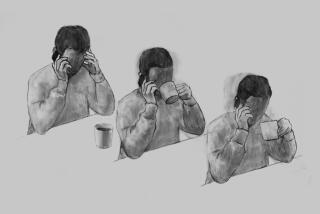Not Just for Kids: ‘Every Day’ has heart and soul
- Share via
It’s the rare book that challenges gender presumptions in a way that’s as entertaining as it is unexpected and, perhaps most important, that’s relatable to teens who may not think they need sensitivity training when it comes to sexual orientation and the nature of true love. “Every Day,” from New York Times bestselling author David Levithan, is precisely such a book.
Clever, bittersweet and utterly un-put-down-able, “Every Day” is a love story told from the most unusual of perspectives. It’s written in the voice of a character named A, who is 16 years old and genderless — a soul, really, who wakes up as a different person each day. This “shift” has been happening for as long as A can remember, which, at the book’s beginning, is 5,993 days.
During that time, A has temporarily inhabited the bodies of boys and girls of A’s age, many of them in the state of Maryland. No details are given as to why A has ended up living this way — only that A has developed a code of conduct that involves leaving the life as close to the same as it was when A took it over.
All of that changes on Day 5,994, when A temporarily inhabits the body of a boy who doesn’t appreciate his girlfriend. A winds up falling in love with the girl after the two skip school and spend an idyllic afternoon at the beach. So begins the complicated task of perpetuating that love when the body in which it resides is constantly changing. In the days after A first meets Rhiannon, A wakes up as Leslie Wong, Skylar Smith, Amy Tran and Nathan Daldry, whose car A borrows to meet up with Rhiannon at a party. As Nathan, A concocts a lie about why this stranger from another school so far away was even there — a lie that begins to unravel when Rhiannon and A start to correspond via email.
This body-switching scenario is complicated, but Levithan does a good job of keeping the rules of such an odd existence streamlined and easy to understand. The “shift” from one life to another usually takes place when A is asleep. A is able to fit into each body’s life by “accessing” the individual’s life story, few of whom have any sense that A was even there afterward.
The rare exception is Nathan, a strait-laced nerd who woke up in his car on the side of the road after A used his body to visit Rhiannon. Nathan knows his body was hijacked. And, because A was using his computer, Nathan has A’s email address and begins contacting him to find out why.
A continues to move from one body to the next, all the while emailing with Rhiannon. It’s a lonely life, but there are positives. A is never in one body long enough to be defined by others. A lives without the peer or parental pressures most teens experience. “When who you are changes every day — you get to touch the universal more,” explains A.
Still, A longs for the sort of personal connection that gives meaning to life, a connection A finds through Rhiannon. A just needs to explain the body-switching to her and convince her of their love, which A does in person — as a cheerleader named Megan.
Over the course of the book’s 40 days — er, lives — A borrows bodies living a gamut of common teen scenarios. Leading so many different types of lives has equipped A with knowledge about a variety of common teen activities that helps A fit in.
The bodies A inhabits are both female and male. Most are heterosexual, though a handful are homosexual and one is transgender. The teens are ethnically, economically and emotionally diverse — a mix of athletes, addicts and straight-A students, of metal heads, mean girls and the obese, of the religious, the home-schooled and the suicidally inclined.
Rhiannon encounters A in about a dozen different “packages,” and that raises an intriguing question about the influence of gender and appearance on true love — whether a soul connection is enough to maintain a relationship. “Every Day” doesn’t provide a definitive answer. It merely posits the idea in a story that is always alluring, oftentimes humorous and much like love itself — splendorous.
More to Read
The biggest entertainment stories
Get our big stories about Hollywood, film, television, music, arts, culture and more right in your inbox as soon as they publish.
You may occasionally receive promotional content from the Los Angeles Times.










